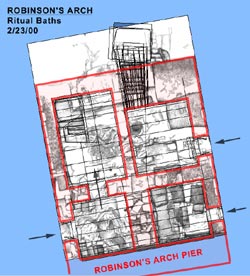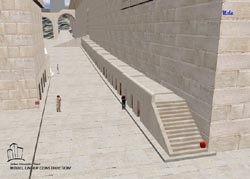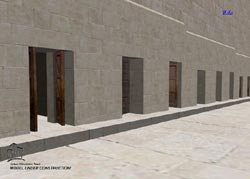|

Using Excavation Plans
 The excavation plans of the Tyropoeon Street provide definitive evidence of small, regular structures along the base of the western wall of the Temple Mount platform and two ritual baths within the support pier of Robinson's Arch.
The excavation plans of the Tyropoeon Street provide definitive evidence of small, regular structures along the base of the western wall of the Temple Mount platform and two ritual baths within the support pier of Robinson's Arch.
To construct the ritual baths (or miqva'ot), the excavation plan was digitized and texture mapped onto a polygon in MultiGen that corresponded to the X and Y coordinates of the corners of the plan area. (In MultiGen, the program used to build the simulation model, points in space are defined by their X, Y, and Z coordinates.)
 The Z is the vertical axis (or elevation about sea level); and the X and Y coordinates represent perpendicular horizontal axes.) The footprints of the baths in plan were then used as a template to trace the different levels of stone. The resulting geometry was raised to the appropriate Z position before the addition of connecting vertical faces. The finished model was texture mapped with a texture of small stones.
The Z is the vertical axis (or elevation about sea level); and the X and Y coordinates represent perpendicular horizontal axes.) The footprints of the baths in plan were then used as a template to trace the different levels of stone. The resulting geometry was raised to the appropriate Z position before the addition of connecting vertical faces. The finished model was texture mapped with a texture of small stones.
 A different approach was dictated by the regular pattern of the 21 shops along the Western wall contained within the excavation area. Using measurements from the excavation plan, a file containing the geometry for three shops was constructed. This file was externally referenced into the model multiple times and each section raised to the appropriate elevation to account for the gentle northern slope of Tyropoeon Street. Since all of the shops were identical, this approach minimized time-consuming changes; modifications to the primary file would automatically update the entire line of shops. Additional sections of shops were externally referenced along the Western wall to the north, broken only by a monumental staircase at Barclay's Gate. The staircase at the southwest corner and the north-south curb were constructed in an independent computer file. A mix of doors, awnings, and indications of shop activity were also constructed independently to break up the repetitive rows of shops.
A different approach was dictated by the regular pattern of the 21 shops along the Western wall contained within the excavation area. Using measurements from the excavation plan, a file containing the geometry for three shops was constructed. This file was externally referenced into the model multiple times and each section raised to the appropriate elevation to account for the gentle northern slope of Tyropoeon Street. Since all of the shops were identical, this approach minimized time-consuming changes; modifications to the primary file would automatically update the entire line of shops. Additional sections of shops were externally referenced along the Western wall to the north, broken only by a monumental staircase at Barclay's Gate. The staircase at the southwest corner and the north-south curb were constructed in an independent computer file. A mix of doors, awnings, and indications of shop activity were also constructed independently to break up the repetitive rows of shops.

|

